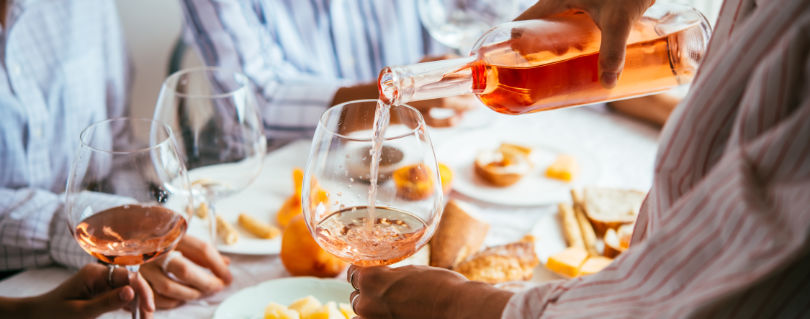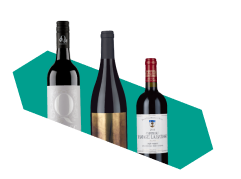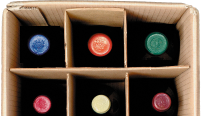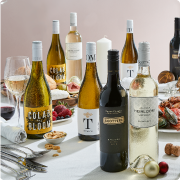There’s nothing better than a delicious rosé to complement a spring brunch or to match a summer sunset over evening drinks.
Ranging from delicate and crisp to lush and fruity, barely pink in colour to a deep raspberry shade, there’s a style of rosé to suit every occasion. Rosé wines are found worldwide, from the southern coast of France to the rolling hills of South Australia.
Rosé wine is typically characterised by notes of red berries, citrus, herbs and rose petals. A glass of chilled pink wine is perfect on its own or paired with food during the warmer months. But what are the best rosé wines and which one will suit your taste?
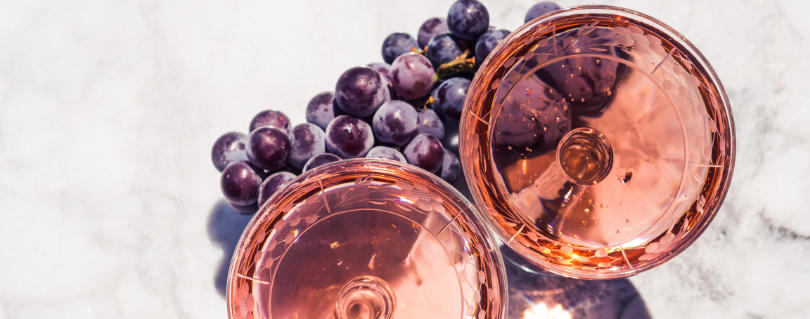
What grape varieties are used to make rosé wine?
Rosé is typically made using red wine grapes and the variety used will influence the wine’s flavour, colour and overall style. Some wineries include native grape varieties in their rosé production.
Some of the most popular international varieties include:
Grenache – This variety is widely used, especially in Australian regions such as McLaren Vale and Barossa Valley. It is also used in Provence for its bright fruitiness and balanced acidity.
Pinot Noir – The grape is commonly used in cooler climate regions such as the Yarra Valley and Tasmania. It is also used extensively in regions like Burgundy and Oregon, producing elegant, light-bodied rosés.
Sangiovese – This Italian grape creates rosé (or rosato) wines with fresh cherry flavours and pronounced acidity. Expect to find it in rosé wines from McLaren Vale and King Valley.
Syrah (Shiraz) – In France’s Rhône Valley, Syrah/Shiraz adds depth and a spicy note to rosés. It's also widely planted across Australia and used in rosé wines, especially from warmer climates like Barossa Valley and McLaren Vale.
Tempranillo – Often used to create Spanish rosados, this variety has fresh red fruit flavours and a hint of earthiness.
Zinfandel – Popular in California, this red wine grape variety is used to create off-dry, soft rosés, commonly known as White Zinfandel.
One of the most common techniques winemakers use to make rosé is the maceration method. This involves allowing the red wine grapes to be in contact with their skins for a short period (from a few hours to a few days) before the skins are removed and the juice is fermented.
Other techniques include the Saignée Method (winemakers 'bleed off' a portion of the juice from red wine fermentation early in the process), the direct pressing method (gentle pressing with minimal skin contact) and the blending method, which involves mixing a small amount of red wine into white wine.
Shop our full range of premium rosé wines.
The best rosé wine regions
These are just some of the best rosé wine regions from Australia and the rest of the world.
The Barossa Valley
South Australia's Barossa Valley winemakers produce high-quality rosés with diverse flavour profiles, ranging from light and crisp to richer styles. The region is known for its warm climate and old vines. The most popular grape varieties here are Shiraz, Grenache and
Mataro (Mourvèdre). Enjoy these wines' intense strawberry and raspberry flavours, refreshing acidity and robust structure.
Angaston Road Growers Winery Block Barossa Valley Rosé 2023 is as delicious as it looks, with notes of strawberry, orange, zingy citrus and lightly spiced cherry.
McLaren Vale, South Australia
Look out for medium-bodied rosés with a fresher and more vibrant profile in this region. Grenache, Shiraz and Sangiovese are particularly popular grapes used here for rosé production. McLaren Vale rosés have fresh fruit flavours such as watermelon, strawberry, and cherry, complemented by floral notes and lively acidity.
The award-winning Zonte's Footsteps Scarlet Ladybird Rosé is made with fruit sourced from hand-tended blocks in McLaren Vale and Langhorne Creek.
Côtes de Provence, France
One of the most famous regions for rosé, Côtes de Provence rosé is known for its distinctive pale, salmon-pink hue. Made in Provence's sunny Mediterranean climate, these elegant rosés are commonly a blend of Grenache, Cinsault, Mourvèdre and Syrah/Shiraz. They have a dry, clean finish and subtle notes of citrus, red fruits and dried herbs.
Domaine du Mas Ensoleillé Rosé 2023 is a Provençal gem – dry, elegant and citrusy, with a subtle, savoury edge.
Loire Valley, France
With a temperate climate and diverse soil types, the Loire Valley is known for a light, fresh style of rosé. The rosé wines here, made primarily from native Grolleau and Cabernet Franc grapes, are widely popular thanks to their versatility. They are also food-friendly and pair deliciously with everything from seafood to cheese.
Navarra, Spain
Navarra is known as Spain's rosé capital. The region's varied climate – influenced by the Atlantic Ocean and the Mediterranean Sea – is reflected in its wines. Making rosé in Navarra stems from the area's long history of growing Garnacha (Grenache) grapes – these wines are a staple of the region's tapas and pintxos food culture. Navarra's rosados are darker and fruitier than those found in Provence.
Puglia, Italy
Winemakers in this beautiful region in Italy produce rich, full-bodied rosés. These tend to be fruity and aromatic with pronounced flavours of red berries (like strawberries, cherries and raspberries), pomegranate and citrus. The Negroamaro grape is one of the main grapes used in Puglian rosato.
You can also find excellent rosé from Marlborough in New Zealand, South Africa's Stellenbosch region, California's Napa Valley and Alentejo in Portugal, where rosé is most commonly made using Tempranillo (known locally as Aragonez) grapes alongside native varieties.

What foods pair well with rosé wine?
Thanks to the wide variety of styles available, rosé can be paired with many different dishes.
Dry rosés from Provence or the Barossa Valley are perfect paired with light seafood dishes or grilled chicken. Their refreshing acidity and delicate fruit flavours enhance and complement these dishes' fresh characteristics. Drink like the French, and enjoy a glass of Provence rosé with a Niçoise salad.
If you've opted for a light rosé from northern Italy, serve it alongside light salads, fresh pasta dishes and mild cheeses. This rosé can also work well with lightly spiced Asian cuisine thanks to its balance of fruitiness and acidity, which refreshes the palate in-between bites.
Fruity rosé, such as Spanish rosado, is a good choice for pairing with richer, more savoury dishes like barbecued red meats and vegetables – the ripe fruitiness balances out the savoury flavours, while its fuller body can match the weight and texture of the food.
Sweet rosé, like White Zinfandel or some styles of Rosé d'Anjou from the Loire Valley, makes a good pairing for spicy food. The wine's sweetness balances out the heat in dishes – think spicy Pad Thai, Szechuan beef or chicken tacos.
Fruity and vibrant sparkling rosé wines are produced throughout Australia's Yarra Valley, Barossa Valley and Margaret River regions. Pair your bubbly with fresh seafood and charcuterie and light cream-based or fruit desserts.
From Australia to France, Italy to South Africa, we stock delicious rosé from around the world – shop our best rosé wine here.
